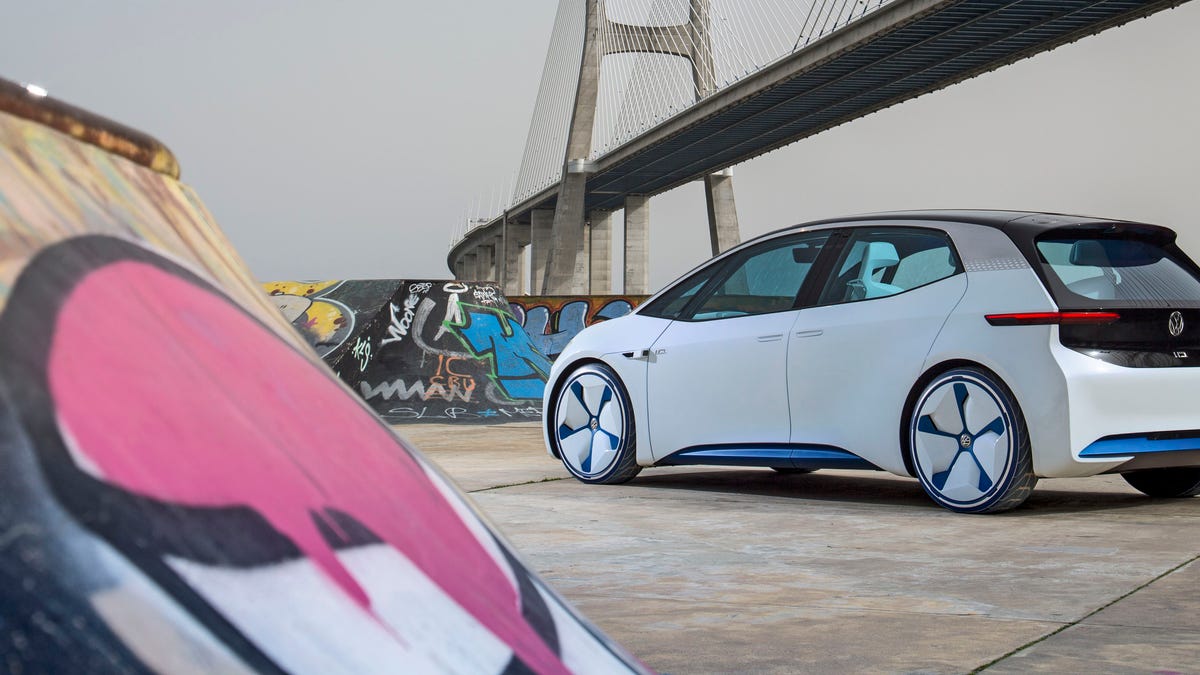The Volkswagen ID concept is the future of 'motoring'
We get behind the retracting wheel of VW's next-generation electric vehicle. Once there was a Beetle, now there's a Golf, soon there'll be the ID.

Fear. It's a funny emotion. It controls you, steers you, envelops you. I was freaking terrified of the literally priceless Volkswagen ID concept, the electric car that VW's touted as the future of motoring.
Here's why I was nervous: It has no B-pillar, so it has the structural rigidity of a paper plane. The tires have 2.5 millimeters of special blue tread on them, and I was told that it basically peels off if it sees a steep corner. When I drove over anything bumpy, the car would violently shake. The speedometer didn't work. The navigation told me I was in Paris because the system was set to "show mode" and is also a bit fake.
Some of the car's minders were following me in a different car, and another was in the back seat telling me to slow down. Apart from when he told me to go fast because the throttle calibration was a bit jumpy and the car started to judder for no apparent reason. When that happened, the only fix was more power.
There is only one of these in the world. There will only ever be one of these. This is the beginning of something huge for Volkswagen, and I didn't want to be the chump who binned it.
The size and speed of a Golf, yet no emissions.
The ID concept is a statement of intent from VW. It promises that by 2020 the first electric ID production cars will be on the road. They'll sit alongside the Golf, cost the same as a diesel Golf and they'll be on MEB, the VW Group's new electric-friendly platform. When the ID launched in 2016, VW was at pains to point out that small cars needed a bit of jolt, and this was the car to take the next big step.
In concept form, the ID is pretty impressive. It's fully autonomous, with cameras and sensors dotted subtly and stylishly around the exterior to help it find its way around town. Should it detect a pedestrian, its headlamps will let them know what's going on as well. When the driver activates autonomous mode, the steering wheel retracts into the minimalist dash, allowing the driver to just "be" -- very zen.
Power comes from a 168 horsepower electric motor with a range of 249-373 miles. It'll hit 62 mph in under eight seconds, and it'll manage 99 mph on the top end. So, it's quick enough for most people.
The only control you have to put any effort into is the steering and pedals -- the rest are sorted by a simple touch. The gears are selected by pressing gently on the corresponding letter on the wheel, though you do have to watch you don't knock it into neutral while you're making a big turn.
Run your finger along the door handles and they'll pop from their flush position to meet your hand. While the front door is conventional, the rear slides back, revealing the lack of B-pillar and more access space than most people will realistically ever need. Because there's no big engine and transmission tunnel, there's more space inside than a regular hatch, so four adults can fit in there with no problem at all. And you needn't worry about passengers getting in the way of your rear view mirror because that's actually a camera mounted on the rear of the car. The wing mirrors are gone as well, also cameras.
It sits on preposterously large wheels for a small car, which make the ride bumpy, but also look fantastic.
They make look great on the show floor, but on the road... not so great.
As it's a concept, all the autonomous stuff, the performance figures, the range... everything is all a pipe dream. Some simulated, targeted numbers to show off what the ID will likely do in 2020 when the production car hits real roads. In reality anything more than 15 mph was unlikely and rather daunting.
Being a concept, it was designed to sit on a show stand, maybe drive on and off a stage, and that's about it. Taking on a real road is a different ball game. It juddered, flexed and didn't seem too happy about being driven, but it moved well enough to be a fantastic statement of intent for what's to come in 2020.
When the real ID comes, it'll sit alongside the Golf, until, I imagine, enough people make the switch from combustion to electric and refuse to go back. The real car will, I'm told, look similar to the concept with a few notable differences. Full autonomy won't be an option just yet as it's too expensive. The jazzy door handles may help aerodynamics, and therefore range, but they'll have to go. The wheels may look good but won't be giant and white, and there will be actual wing mirrors because legislation hates cool stuff.
However, the interior tech will be bang up to date, so expect to control just about everything with your phone. It'll hopefully look as similar to the concept as possible (please make it so, VW -- the number of people stopping to take pictures of it was unreal) and it'll ease worries about range anxiety. I mean, 373 miles on a charge? From a car that costs the same as a diesel Golf? I know where my money would go (if I didn't live in a first-floor flat and could afford a diesel Golf).
I may have been terrified I was going to break a piece of history, but only because one day that concept may well be looked upon as the car that kicked off VW's electric revolution -- and that made the combustion engine start to sweat.

